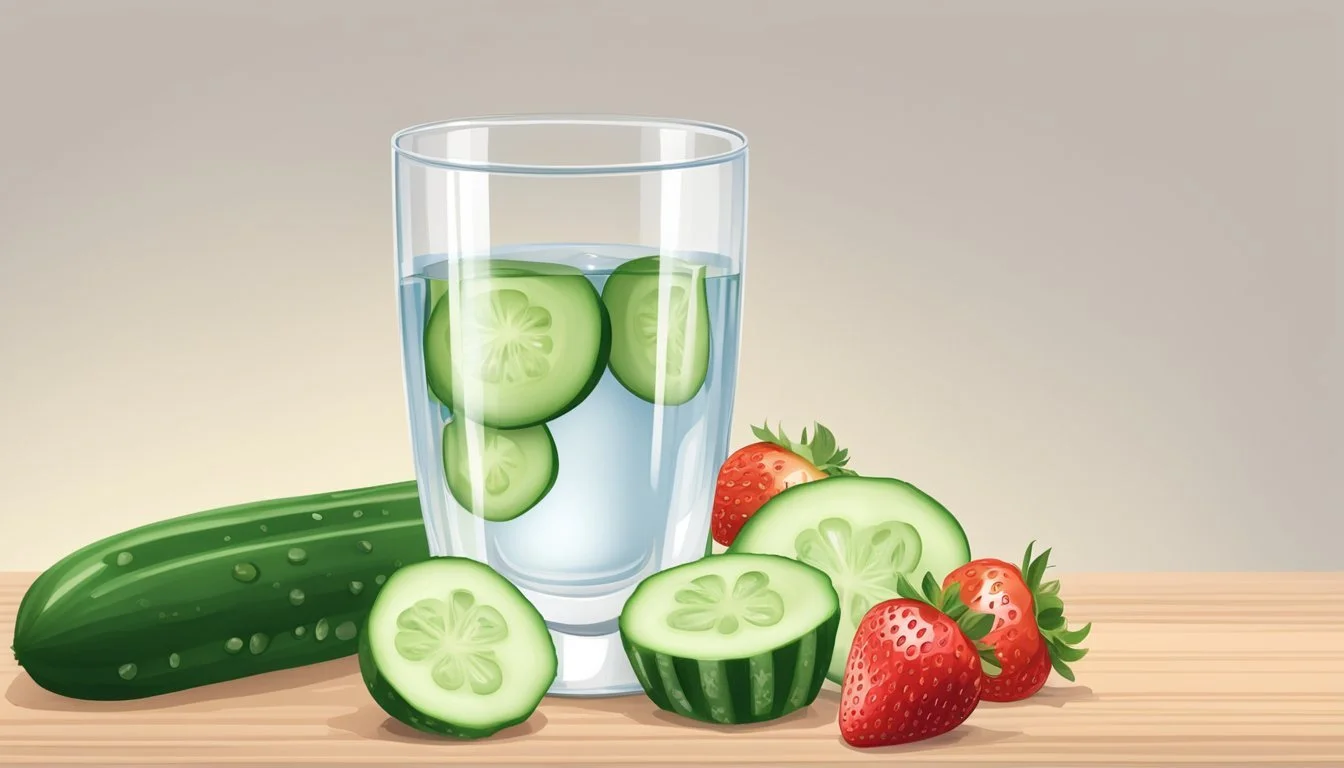How Much Silica to Include in Your Diet for Optimal Skin Health
Silica, a mineral found abundantly in nature, plays a crucial role in maintaining healthy skin. Often overlooked in discussions about diet and skin health, silica aids in the formation of collagen, the protein that keeps skin elastic and youthful. It's found not only in cosmetic and skincare products but also available through dietary sources.
Incorporating silica into one's diet is a natural approach to enhancing skin health. The mineral's ability to promote oxygen transport aids in nourishing the skin, resulting in a more radiant complexion. While silica is not typically included in standard nutritional guidelines, its benefits for the skin suggest that a conscious effort to include silica-rich foods such as brown rice, bananas, and green beans could be beneficial.
A balanced intake of silica could support not only the skin's appearance but also its ability to repair and regenerate. With its potential to strengthen the connective tissues of the skin, silica is an element worth considering for anyone seeking to optimize their dietary regimen for skin health. The exact amount of silica required for optimal skin health is not clearly defined, reinforcing the importance of a varied and balanced diet that includes multiple sources of this vital mineral.
Understanding Silica
Silica is a mineral that plays a crucial role in maintaining skin health, acting as a building block for collagen and promoting connective tissue health. This section delves into what silica is, its natural occurrence, its nutritional role, and its associated health benefits.
Defining Silica and Silicon Dioxide
Silica, also referred to as silicon dioxide, is a compound made of silicon and oxygen. It's commonly found in nature as quartz and in various living organisms. As a trace element necessary for the human body, it contributes to the structure and function of connective tissue.
Natural Occurrence of Silica in the Earth and Plants
Silica is abundantly present in the earth's crust and is a primary component of sand, rocks, and minerals. Plants absorb silica from the soil, which then contributes to their structural integrity and strength. Foods such as whole grains and leafy greens are common plant-based sources of dietary silica.
Silica as a Nutrient for Overall Health
As a nutrient, silica is crucial for overall health, with its presence influencing various bodily processes. It aids in the formation of collagen, enhances connective tissue health, and plays a role in the optimal functioning of blood vessels. Silica helps transport oxygen and nutrients through the blood, supporting cellular health.
Health Benefits of Silica
Silica offers numerous health benefits:
Skin Health: Supports collagen synthesis, improving skin elasticity and reducing the appearance of wrinkles.
Bone Health: Enhances bone density and strength, playing a role in bone calcification.
Joint Health: Contributes to the health and flexibility of joints, potentially easing discomfort associated with conditions like arthritis.
It is evident that silica is a valuable mineral for skin health and overall physiological functioning. By including silica-rich foods like whole grains, green beans, lentils, and spinach in one's diet, an individual can harness these benefits for better health and well-being.
The Role of Silica in Skin, Hair, and Nails
Silica plays a crucial role in the health of skin, hair, and nails by contributing to their strength, resilience, and overall appearance.
Improving Skin Elasticity and Collagen Production
Silica is instrumental in promoting skin elasticity and collagen production. It acts as a pivotal component in the formation of collagen, the protein that maintains the skin's strength and suppleness. Regular silica intake can help diminish the appearance of fine lines and wrinkles, thereby supporting the skin's youthful look and feel.
Enhancing Hair Strength and Preventing Hair Loss
When it comes to hair, silica is known to enhance strength and prevent hair loss. Silica's presence contributes to the integrity of hair strands by delivering essential nutrients to the hair follicles. This not only helps in preventing hair thinning but also supports the growth of healthier, more robust hair fibers.
Supporting Nail Growth and Strength
For nails, silica provides vital support for growth and strength. Adequate levels of silica help in the formation of nail tissue, ensuring nails are less prone to breakage and maintain a healthy, polished appearance. Reinforced nails are also a sign of good overall nutrient intake, which reflects positively on overall health, including that of the skin and hair.
Silica in Your Diet
Silica, a trace mineral essential for health, particularly influences skin health. A diet that includes adequate amounts of silica helps maintain skin elasticity and promotes healing.
Identifying Silica-Rich Foods
The incorporation of silica-rich foods into one's diet is crucial. Vegetables such as spinach and other leafy greens are known for their higher silica content. Whole grains like oats and brown rice are also excellent sources, with brown rice providing approximately 4.51 milligrams per three heaped tablespoons. Fruits often contain silica with bananas being a notable example. In terms of beverages, tea and beer are traditionally high in silica due to the water and natural ingredients used in their production.
It's important to consider variety in a daily routine, ensuring that silica intake is balanced alongside other nutrients. Here is a simple list of common silica-rich foods to include in meals:
Vegetables: Spinach, Cucumber
Whole grains: Oats, Brown Rice
Fruits: Bananas
Beverages: Tea, Beer
Silica Supplements vs. Food Sources
Choosing between silica supplements and natural food sources will depend on personal dietary needs and preferences. Supplements offer a concentrated dose of silica and are usually taken in liquid form, approximately 1 tablespoon (15 mL), ideally before a meal for optimal absorption. However, obtaining silica from food sources allows for a variety of nutrient intake and promotes a balanced diet.
Foods naturally contain dietary silica, which can be a more sustainable way of maintaining silica levels without reliance on supplements. For example, integrating whole grains like oats into breakfast or enjoying a banana as a snack can effectively boost silica intake.
Careful consideration should also be given to processing, as refined foods tend to have lower silica content compared to their whole or unprocessed counterparts. It's important to maintain a balance and not to over-rely on supplements, as they are intended to complement a diet, not replace it.
Recommended Daily Intake of Silica
Understanding the recommended daily intake of silica is crucial for maintaining skin health, as silica plays a pivotal role in the formation of collagen. The guidelines for silica consumption are based on age, dietary sources, and the body's ability to absorb this mineral.
Silica Dosage Guidelines
For adults aged 19 to 50, 9-14 mg/day is considered the adequate daily intake of silica. When aiming to support skin health, it's essential to maintain this level of intake consistently. Here are key points regarding daily dosage:
Adults (19-50 years): 9-14 mg/day
Beyond 50 years: Intake might vary, and consultation with a healthcare provider is recommended to account for changing nutritional needs.
Absorption and Bioavailability
The bioavailability of silica in the diet is affected by various factors, including the food source and the presence of other compounds that may enhance or hinder its absorption. For optimal absorption, incorporating a variety of silica-rich foods is beneficial:
Whole grains: High in fiber, aiding in silica absorption.
Fruits & Vegetables: Particularly those high in dietary fiber.
Silica in Different Life Stages
Silica intake might need adjustment as one progresses through different life stages:
Children and Adolescents: Exact amounts vary, but ensuring a diet rich in vegetables and whole grains can support developing tissues.
Older Adults: Monitoring intake is vital as dietary habits or digestive efficiency may change, potentially affecting silica levels.
Incorporating a balanced diet with adequate levels of silica is supportive of skin health, as well as overall well-being.
Benefits and Efficacy of Supplemental Silica
In the pursuit of enhanced skin health, supplemental silica has shown to offer significant benefits. This section delves into the types of silica supplements and their effectiveness.
Comparing Forms of Silica Supplements
When considering silica supplements, consumers encounter a choice between plant-based and mineral-based options. Plant-based silica supplements often derive from sources like the horsetail plant, which boasts a high natural concentration of silica. They may also include additional herbal ingredients, like rosemary leaves, that serve as natural preservatives.
In contrast, mineral-based silica supplements typically focus on the mineral in its isolated form, sometimes suspended in a medium like reverse osmosis water to ensure purity and remove impurities. The choice between plant-based and mineral-based silica supplements should consider the source of silica and any additional benefits or compounds included within the formulation.
Assessing the Effectiveness of Silica Supplementation
The effectiveness of silica supplementation is often gauged by its impact on hair, skin, and nails—areas where silica plays a crucial role. Research has indicated that silica can support the formation of collagen, which is vital for the strength and elasticity of skin. Moreover, silica is associated with:
Enhanced skin luminosity
Reduction in brittleness of hair and nails
Support for skin repair processes
Individuals interested in silica supplementation should consult with a healthcare professional to customize dosage based on specific health goals and needs. The advised daily intake of silica can vary, but for adults, it is generally recommended to be between 9-14 mg/day. It's important to note that the effectiveness of supplements can be influenced by the body's ability to absorb and utilize the silica, which can differ from person to person.
Safety and Considerations
When incorporating silica into your diet for skin health, understanding the balance between beneficial effects and safety concerns is crucial. It is important to be aware of potential side effects and know when professional medical advice is warranted.
Potential Side Effects of Silica
Silica is generally considered safe when consumed in appropriate amounts found in foods. However, excessive intake of silica may lead to unwanted outcomes. Side effects can range from mild gastrointestinal discomfort to more serious conditions. Here is a summary of potential silica-related side effects:
Gastrointestinal issues: Nausea, bloating, and diarrhea.
Lung disease: Excessive inhalation of silica dust can lead to conditions such as silicosis, particularly in occupational settings.
Kidney disease: High levels of silica may contribute to kidney dysfunction in susceptible individuals.
When to Consult a Healthcare Professional
Individuals should consult a healthcare professional if they experience symptoms that might be linked to silica supplements or if they have pre-existing conditions that could be exacerbated by silica intake. Concerns typically arise in the following scenarios:
Pre-existing conditions: Those with kidney disease, heart disease, or lung conditions might require medical advice before increasing silica intake.
Symptoms after supplementation: If symptoms suggesting adverse reactions to silica supplements appear, such as persistent gastrointestinal problems or changes in urination.
Regulatory Perspective on Silica as an Additive
The Food and Drug Administration (FDA) recognizes silicon dioxide, a form of silica, as a safe food additive, primarily used as an anti-caking agent to prevent clumping. Here are specifics regarding regulatory status:
As an additive: The FDA has listed silicon dioxide as Generally Recognized as Safe (GRAS) under certain conditions of use.
Limits and conditions: While it is permitted in food, the FDA stipulates that it should not exceed 2% of the food’s weight.
Disease links: Current research has not established a direct link between dietary silica and diseases like Alzheimer’s disease or heart disease.
It is crucial to adhere to FDA guidelines and established safe consumption levels to minimize risks associated with silica intake.
Silica Beyond Diet
Silica's role in the body extends beyond dietary intake and contributes to various industrial and health contexts. It's important to understand the implications of environmental exposure to silica and its connection to chronic conditions as researched in different studies.
Silica in Industries and Environmental Exposure
Industries extensively utilize silica, especially in the form of quartz, for its physical and chemical properties. It serves a critical function in the production of glass, ceramics, concrete, and electronics. Such industrial activity releases silica particles into the environment, potentially leading to widespread exposure. Environmental exposure to silica dust can occur in workplace settings or regions where these materials are produced or used extensively.
The concern about environmental silica exposure is mainly related to respiratory health. When inhaled, fine silica particles can lead to conditions like silicosis, a lifelong lung disease marked by inflammation and scarring of the lung tissue. There is evolving evidence that silica exposure is linked not just to silicosis but also to other diseases such as chronic obstructive pulmonary disease (COPD) and even lung cancer. Adequate ventilation, dust control measures, and personal protective equipment are essential to managing and minimizing this risk in industrial contexts.
Research on Silica and Chronic Conditions
Research has explored how silica behaves in relation to chronic health conditions, such as diabetes, heart disease, and its effects on wound healing. Studies suggest that silica may have favorable effects on would healing and tissue repair, due to its involvement in the synthesis of collagen, a key protein in healing processes.
Diabetes: Some studies indicate that silica could play a role in the metabolic processes related to diabetes.
Heart Disease: Research into the links between silica and heart disease is ongoing, with some studies suggesting potential protective effects.
Silicosis, as a direct result of silica dust inhalation, is a well-documented chronic condition. It shows the dual nature of silica; while it can be beneficial in controlled amounts, excessive inhalation poses significant health risks.
The conversation around silica, within the context of chronic conditions, is ongoing. While recognizing the health benefits of silica in the diet and its roles in various industries, there is a clear need for continued research to fully understand the complex relationship between silica and chronic health conditions. It's prudent to approach the topic with the understanding that the health effects of silica are wide-ranging and subject to individual environmental and occupational variables.
Incorporating Silica into Your Daily Routine
Silica is a trace mineral important for skin health and overall well-being. To incorporate silica into one's daily diet, focus on natural food sources that are abundant in this mineral. Whole grains, such as barley, oats, and brown rice, are staples to consider. Oats, in particular, can be easily included in breakfast cereals or smoothies.
Vegetables are also silica-rich. Green beans, lentils, asparagus, and celery contribute to a balanced intake of silica and can be seamlessly added to soups, salads, or main dishes. Cucumbers are another excellent source and make for a refreshing snack or salad ingredient.
For those looking to enhance their silica intake, herb-based supplements such as horsetail and nettle offer concentrated sources of silica. These can be consumed in tea or capsule form as part of a daily supplement regimen.
Fruit sources like bananas offer silica in addition to potassium and magnesium, synergistically supporting mineral balance in the diet.
Nuts, especially almonds, are not only a good source of healthy fats but also contain silica.
It's advisable to combine dietary sources of silica with other essential minerals like calcium, magnesium, and potassium to support overall health. These minerals can be found in foods such as dairy products, leafy greens, and nuts.
For those considering a supplemental form of silica, Living Silica products are available. When choosing supplements, it's crucial to opt for reputable brands and to consult with a healthcare provider, especially if there are any underlying health conditions or if one is on medication.





